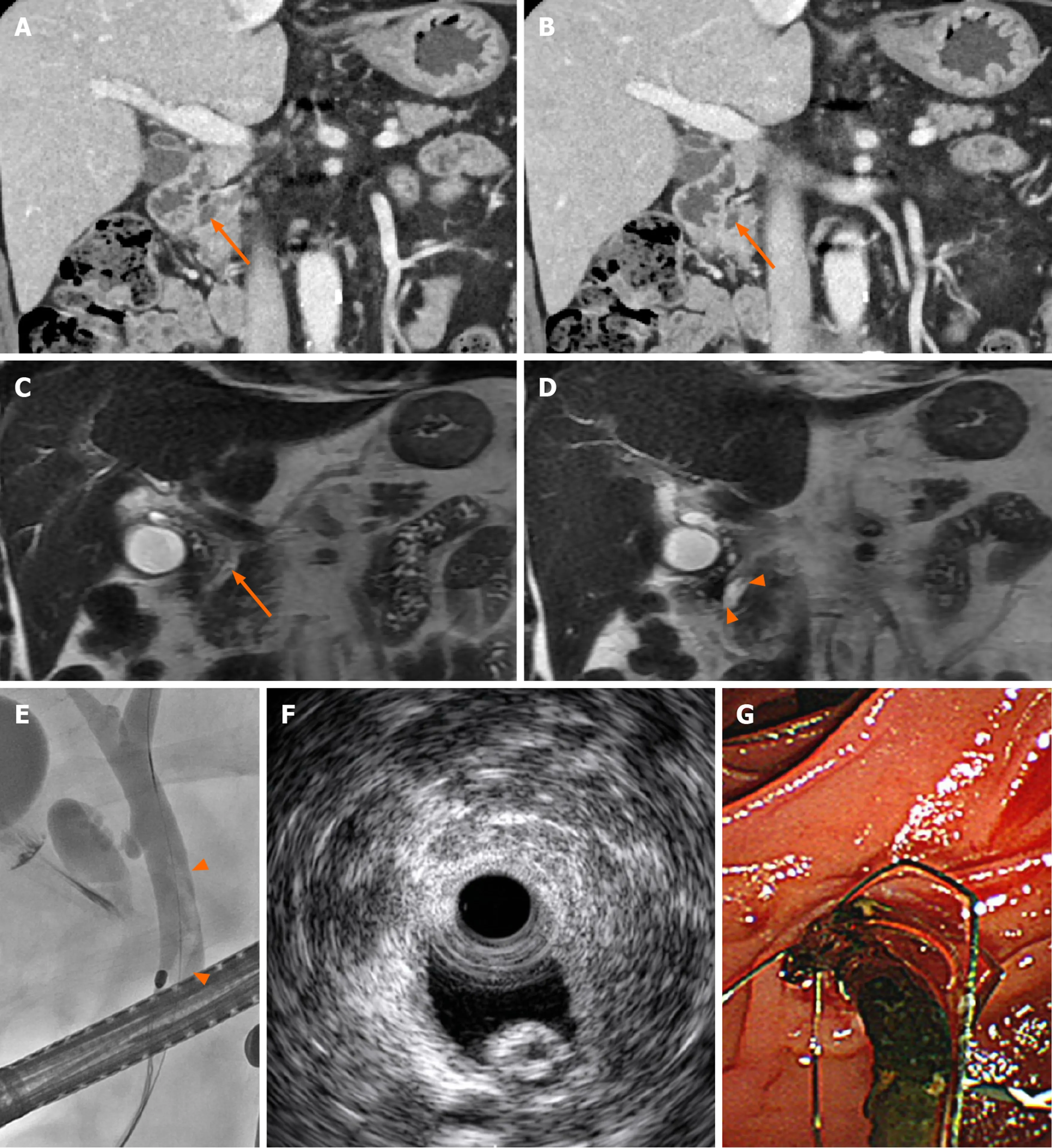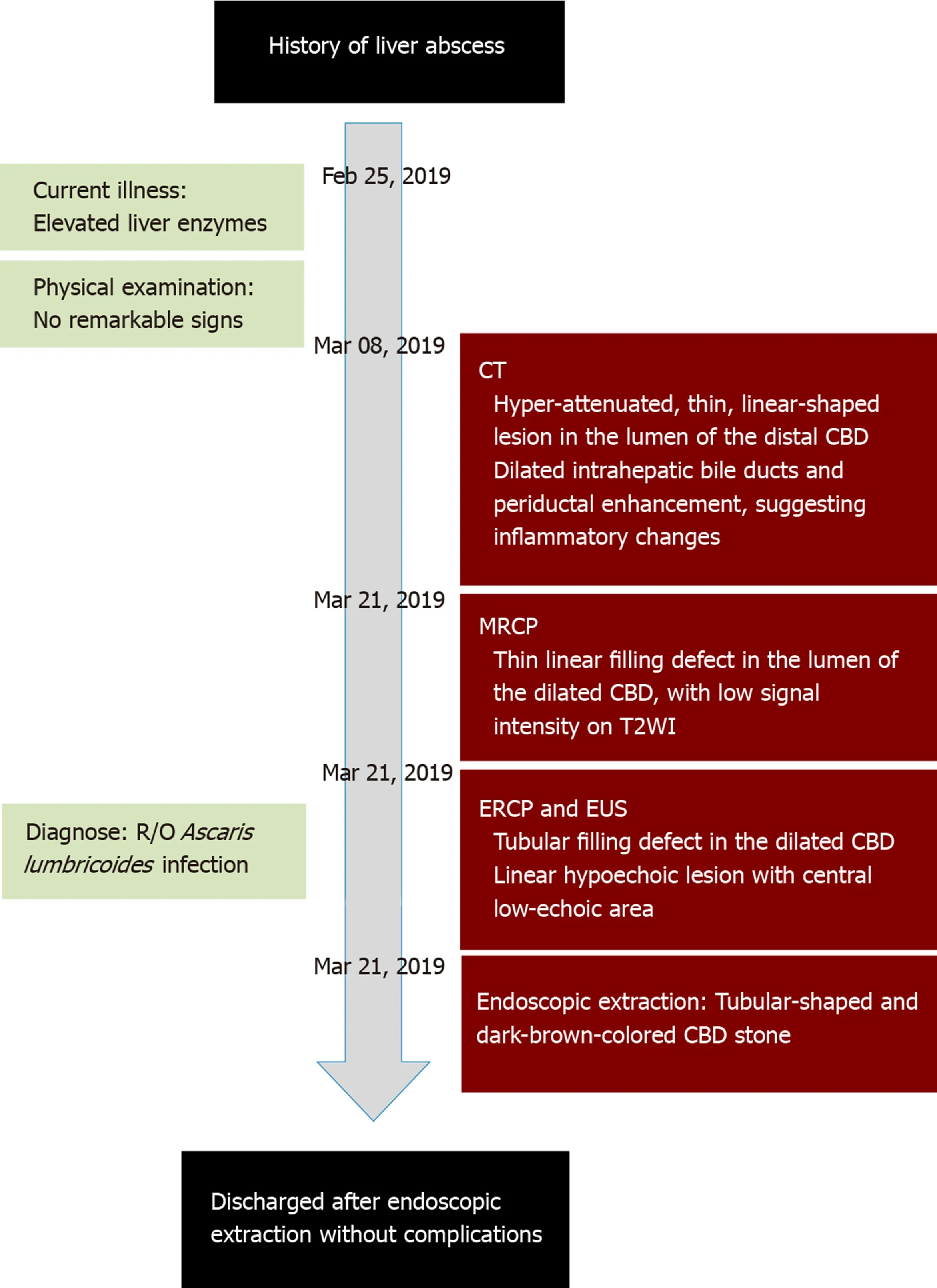Ascaris-mimicking common bile duct stone:A case report
Seo-Youn Choi,Ha Eun Jo,Yun Nah Lee,Ji Eun Lee,Min Hee Lee,Sanghyeok Lim,Boem Ha Yi
Seo-Youn Choi,Ha Eun Jo,Ji Eun Lee,Min Hee Lee,Sanghyeok Lim,Boem Ha Yi,Radiology,Soonchunhyang University Hospital,Bucheon,Bucheon 14584,South Korea
Yun Nah Lee,Digestive disease center and research institute,Soonchunhyang University Hospital,Bucheon,Bucheon 14584,South Korea
Abstract BACKGROUND In most cases,it is not difficult to differentiate common bile duct(CBD)stone from Ascaris infection because they are different disease entities and have different imaging findings.The two diseases usually demonstrate unique characteristic findings on computed tomography or magnetic resonance cholangiopancreatography.However,we report a rare case from our experience in which a CBD stone mimicked and was misdiagnosed as Ascaris.CASE SUMMARY A 72-year-old male presented with elevated serum liver enzymes.Computed tomography showed a hyper-attenuated,elongated lesion in the CBD lumen and associated biliary inflammation.Magnetic resonance cholangiopancreatography and endoscopic retrograde cholangiopancreatography revealed a linear filling defect in the bile duct.Moreover,elongated echogenic material with a central hypoechogenic area was seen on endoscopic ultrasound.Although the imaging findings caused us to suspect infection with the nematode Ascaris,the lesion was revealed to be a dark-brown-colored CBD stone through endoscopic extraction.CONCLUSION We report a rare case of a CBD stone that mimicked Ascaris.We also review the literature for side-by-side comparisons of the imaging features of CBD stones and ascariasis.
Key Words:Case report;Common bile duct;Gallstones;Ascaris;Ascariasis;Multidetector computed tomography;Magnetic resonance cholangiopancreatography
INTRODUCTION
Choledocholithiasis,or common bile duct(CBD)stones,is a relatively common disease,and 10% to 15% of people with gallstones also have stones in the bile duct[1,2].Biliary stones usually have angulated shapes or lamellated appearances and commonly accompany biliary inflammation.CBD stones are not difficult to diagnose when they manifest as high-density lesions in the distal CBD lumen without enhancement on computed tomography(CT)and when they demonstrate biliary filling defects with relatively low signal intensity on T2-weighted images of magnetic resonance(MR)cholangiography[2].
However,Ascaris infection can complicate diagnosis of choledocholithiasis.Although its incidence has been decreasing,ascariasis is still an important cause of pancreatobiliary disease in Asia,Africa,and South America.The worms are usually found in the intestinal lumen,but they occasionally move into the bile duct and gallbladder through the ampulla of Vater[3].Diagnosis of hepatobiliary ascariasis can be made by visualizing the larvae in the biliary tree,as they may manifest as a cylindrical filling defect with or without movement on imaging studies[4].
Usually,there is little confusion in differentiation of CBD stone and Ascaris since they are different disease entities with different imaging manifestations.However,we report a case of a CBD stone that mimicked and was misdiagnosed asAscaris lumbricoides.
CASE PRESENTATION
Chief complaints
A 72-year-old male visited our outpatient clinic with elevated liver enzymes.
History of present illness
He did not complain of any symptoms.
History of past illness
He had been previously admitted to our hospital for a liver abscess about 10 years prior,when he had visited our outpatient clinic.
Physical examination
There were no remarkable signs,and his vital signs were normal.
Laboratory examinations
Laboratory values revealed conspicuous elevation of alkaline phosphatase and gamma-glutamyl transpeptidase(γ-GT)in addition to mild elevation of serum amylase.
Imaging examinations
On CT(Figure 1A and B),a hyper-attenuated,thin,linear-shaped lesion was found in the lumen of the distal CBD.In addition,dilated intrahepatic bile ducts and periductal enhancement on the arterial phase suggested inflammatory changes of the intrahepatic bile duct.MR cholangiopancreatography(MRCP;Figure 1C and D)revealed a thin,linear filling defect in the lumen of the dilated CBD that had low signal intensity on T2-weighted images,and the findings were sufficient to diagnose a parasitic larva,such as Ascaris.Subsequently,endoscopic retrograde cholangiopancreatography(ERCP)demonstrated a tubular filling defect in the dilated CBD(Figure 1E),and a linear,hyperechoic lesion with a central low-echoic area was seen on endoscopic ultrasound(EUS)(Figure 1F).

Figure 1 A 72-year-old male with a distal common bile duct stone mimicking Ascaris.A and B:Coronal reformatted images of contrast-enhanced computed tomography showed a hyperattenuated,elongated lesion inside the distal common bile duct(CBD)lumen(arrows);C and D:A T2-weighted coronal image revealed a linear filling defect in the distal CBD lumen with mild ductal dilatation,findings that mimic an Ascaris worm;E and F:An elongated tubular filling defect was seen on endoscopic retrograde cholangiopancreatography,and a hyperechoic lesion with a central hypoechoic area was seen on endoscopic ultrasound;G:A darkbrown-colored CBD stone was discovered through endoscopic removal.
MULTIDISCIPLINARY EXPERT CONSULTATION
After removal by an endoscopic procedure,the lesion was found to be a tubularshaped CBD stone(Figure 1G).
FINAL DIAGNOSIS
The final diagnosis was CBD stone.
TREATMENT
The patient was treated with antibiotics for three days and was discharged without any complications(Figure 2).
OUTCOME AND FOLLOW-UP
Subsequent follow-up blood tests conducted at an outpatient clinic showed gradual decrease in the abnormal liver function test values.
DISCUSSION
Unless it is radiolucent,a CBD stone is not difficult to diagnose on CT.Biliary stones can appear in various attenuations on CT,and only about 20% show high attenuation[5].Most biliary stones are either round or amorphous-shaped.In addition to the imaging findings from the biliary stone itself,low attenuated bile surrounding the stone and associated ductal dilatation or narrowing can improve the likelihood of correct diagnosis of biliary stone[5].In addition,a signal void in the CBD or a fluid level with low signal intensity in the dependent portion of the CBD on MR imaging can suggest a CBD stone[6].Even though ERCP is an invasive procedure,it has the benefit of simultaneous diagnosis and treatment[7].Moreover,EUS has excellent diagnostic ability when it is performed with ERCP,and a biliary stone can be characteristically seen as a hyperechoic lesion accompanying a posterior acoustic shadow in the CBD on EUS[8,9].
On the other hand,Ascaris can appear as an elongated,high-density structure in the biliary tree on CT,although this modality is only used as complementary for diagnosis[6].On MR cholangiogram,Ascaris demonstrates a“double-tube”appearance,a hypointense tubular defect inside the CBD with central hyperintense material representing the fluid-filled gut of the worm[10].On ERCP,the worm is seen as an intraductal filling defect with motility in the bile duct[4,11].The difference between CBD stone and Ascaris is even more obvious on EUS,in which the parasite appears as a spherical-shaped hyperechogenic lesion without posterior acoustic shadowing[12].
To the best of our knowledge,there has been only one case report of CBD stone mimickingAscaris lumbricoides,and the report only described the sonographic findings[11].Thus,it is not thought to be difficult to distinguish CBD stone from Ascaris infestation on imaging or clinical findings.Although they share radiologic findings of a non-enhancing high-density lesion on CT and a filling defect on T2-weighted images on MR,these two diseases rarely are part of the same differential diagnoses because their typical presentations are different.However,if these typical imaging features are not seen,differential diagnosis for tubular structures in the CBD could be confusing.Although we had never previously experienced an elongated-shaped CBD stone,we did experience an ascariasis patient who manifested similar imaging findings to the present case(Supplementary Figure 1).
In the present case,not only did the stone appear very similarly shaped to an Ascaris worm on CT and MR cholangiography,but it was also mistaken for Ascaris on EUS due to its elongated shape with a central hypoechoic area,rather than the nodular or angular appearance of a typical CBD stone.However,Ascaris could have been distinguished from a CBD stone in the present case by the relatively longer(15-49 cm)and thicker(2-6 mm in females)[13]body size of Ascaris compared to CBD stones,even if no motility was observed[14].
Although this was a rare case of CBD stone mimicking biliary ascariasis,it serves as a reminder that patients complaining of biliary colic or imaging finding of an elongated filling defect occupying the CBD should not be diagnosed by shape alone,and a CBD stone can mimic biliary Ascaris.

Figure 2 Timeline of the patient’s illness.CT:Computed tomography;CBD:Common bile duct;MRCP:Magnetic resonance cholangiopancreatography;ERCP:Endoscopic retrograde cholangiopancreatography;EUS:Endoscopic ultrasound.
CONCLUSION
Although CBD stone and Ascaris are not commonly discussed in the same differential diagnosis,they can be confused in cases with an elongated CBD stone.
 World Journal of Clinical Cases2020年19期
World Journal of Clinical Cases2020年19期
- World Journal of Clinical Cases的其它文章
- Role of monoclonal antibody drugs in the treatment of COVID-19
- Review of simulation model for education of point-of-care ultrasound using easy-to-make tools
- Liver injury in COVID-19:A minireview
- Transanal minimally invasive surgery vs endoscopic mucosal resection for rectal benign tumors and rectal carcinoids:A retrospective analysis
- Impact of mTOR gene polymorphisms and gene-tea interaction on susceptibility to tuberculosis
- Establishment and validation of a nomogram to predict the risk of ovarian metastasis in gastric cancer:Based on a large cohort
